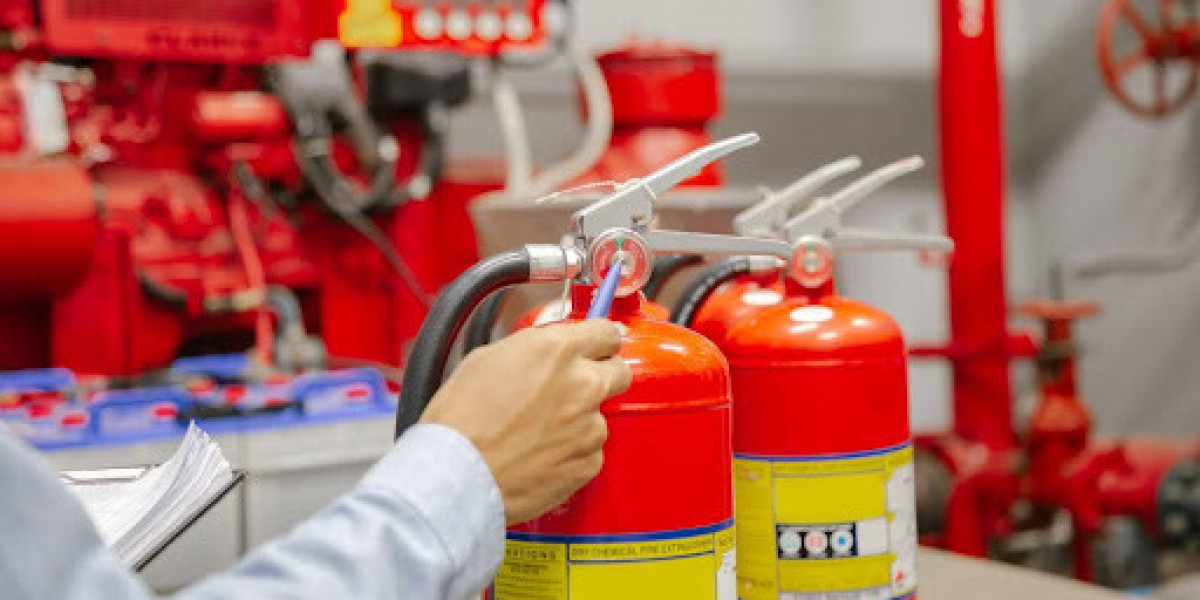Originally Posted On: https://acefireextinguishers.com/service/fire-extinguisher-sales-and-service-explained/
Ever stare at a dusty red cylinder on the wall and wonder, Is this thing actually ready? Same. I’ve hauled a 20‑lb ABC up four flights in August (don’t recommend) and learned real quick that tags, dates, and parts matter more than the sticker. If you’re sorting out where to get fire extinguisher inspected without drama or guesswork, you’re in the right spot.
We help local owners pick between replacement and a simple annual tune‑up so they stay compliant and actually protected. Need a fast NYC fire extinguisher inspection with real documentation—not just a tag? Yeah, that’s our daily rhythm.
Portable units are first‑aid tools for fires, and yearly service is more than eyeballing a gauge. Pros swap worn hoses, o‑rings, pins, valves—whatever keeps the unit reliable and ready. After any discharge, it gets refilled before the tag goes back on. NFPA 10 lays out the checks: location, access, legible instructions, seals, correct pressure, weight, no corrosion or leaks. Simple list, saves headaches.
We’re ACE Fire Protection at 119 Hausman St., Brooklyn, NY 11222—call (718) 608‑6428 for straight answers and quick scheduling.
Key Takeaways
Know when replacement makes sense versus annual care.
Annual checks can include parts replacement to keep units ready.
Recharge after any discharge before tagging the unit.
Follow NFPA 10 points for access, visibility, and condition.
We document work to keep your building protected and compliant.
Brooklyn’s Trusted Partner for Fire Protection, Sales, and Maintenance
Brooklyn buildings are… eclectic—pre-war walkups, sleek glass, new fit‑outs—all mixed on the same block. We’ve seen it all, and we follow manufacturer specs and code so your setup just works. When we wrap, labels face out, cabinets shut right, and your records are clean.
We keep annuals simple: cleaning, corrosion checks, weighing cylinders where required, new pins and seals, sturdy brackets or cabinets. And yes, if you’ve got a temporary jobsite or an event, we set up fire extinguisher rentals fast so coverage never slips.
Documentation is as necessary as the hardware. After each visit, you get a dated tag and a short, readable report so you’re ready for inspections and audits. Less panic, more predictability.
Fire Extinguisher Sales and Service
We size units to your space, stock trusted brands, and install cleanly on brackets or in cabinets. Full‑lifecycle support means purchase, refills, recharges, repairs, scheduled testing—it’s all one playbook. If you’re comparing vendors for fire extinguisher sales and service, you want speed, code knowledge, and honest recommendations. That’s the whole point.
Annual maintenance can include replacing gauges, hoses, o‑rings, valves, pins, and seals. Hydro intervals are common sense: many stored‑pressure models at 12 years; CO2 and water at 5 years.
Service Type | Interval | Common Actions |
Annual Inspection | Every 12 months | Tags, cleaning, component checks, documentation |
6‑year Maintenance | Every 6 years | Teardown, internal check, part replacement |
Hydrostatic Testing | 5 or 12 years | Pressure testing per standards |
“We deliver clear tags and documentation after every visit so your records stay current.”
We replace worn hoses and other parts to extend equipment life and reliability. After any discharge, we refill and retag units before returning them to service.
When to Replace and When Annual Service Is Enough
A practical assessment beats guesswork. Sometimes a cylinder’s a keeper. Sometimes it’s done—corrosion, dents, leaks, damaged welds, missing labels. When it’s beyond economical repair, we’ll say so plainly.
Clear signs a unit should be replaced
Deep corrosion, punctures, dents, or abrasion on the cylinder
Missing or illegible nameplates or labels
Leaks, weld damage, or inoperable valves and handles
What annual inspections cover beyond the gauge
Annuals aren’t a glance. We clean, weigh specific models, check nozzles, and replace horns, valves, o‑rings, gauges, hoses, and pins when needed. We reinstall tamper seals and attach clear certification tags with a short report.
Recharge or refill after discharge
After any discharge, refilling is required before a new tag is issued. We also plan required intervals for fire extinguisher hydrostatic testing so nothing sneaks past you.
Condition | Action | Why it matters |
Cylinder corrosion or dents | Replace | Structural failure risk |
Missing label or nameplate | Replace | Loss of instructions and compliance |
Worn hose, gauge, seals | Repair or part replacement | Restores reliable operation |
Compliance and Inspection Standards You Can Count On
Knowing the checklist keeps equipment reliable. We follow NFPA 10 so you can focus on your actual work. Inspectors look for proper location, unobstructed access, working pressure indicators, fullness by weight where needed, instructions facing outward, intact tamper seals, and a clean, undamaged cylinder.
Required intervals and testing
Annual inspections are the baseline. Stored‑pressure models get 6‑year maintenance and 12‑year hydros; CO2 and water models run a 5‑year hydro cycle. If you want a seasoned fire protection inspector who actually explains things in plain language—we’ve got you. And if you’re searching for fire extinguisher services near me, you’ll get a fast schedule and clean paperwork.
We check placement, access, gauge status, labels, seals, and physical condition. We manage reminders for annuals, 6‑year, and 12‑year intervals so nothing is missed. After work, we attach a fresh certification tag and update your records from our Brooklyn office.
Types of Fire Extinguishers and Proper Placement
Choosing the right mix starts with a short walk‑through. We map hazards, note traffic paths, and match units to real risks in your rooms. As a trusted fire equipment company, we stock ABC multipurpose, CO2, Class K, clean agents like Halotron, water mist, specialty types like Purple K, foams, cartridge units, and Class D for metals.
Standard models and where they belong
ABC multipurpose — versatile for offices and general spaces
CO2 — ideal for electrical without residue
Class K — built for commercial kitchens
Clean agent (Halotron) — great for server rooms and sensitive gear
Water mist — for areas needing low conductivity
Specialty types — AFFF/FFFP, Purple K, cartridge units, Class D for metals
Placement, visibility, and travel distance
Mount on sturdy brackets or inside marked cabinets so people can see them fast. Keep signage clear, access open, and travel distances to code. We’ll mark and document placements so your team can act with confidence.
Area | Recommended Class | Mounting |
Office / Lobby | ABC multipurpose | Wall bracket, visible label |
Server Room | Clean agent (Halotron) | Cabinet or dedicated bracket, signage |
Kitchen (Commercial) | Class K | Low mount, easy reach near cooking areas |
Laboratories / Shops | Cartridge/specialty class | Secured bracket, clear instructions |
Monthly Checks and Employee Training That Keep You Ready
A quick monthly walk‑through catches minor problems early. OSHA expects monthly inspections by a designated employee, location, access, pressure indicator, and a signed tag. We teach teams to run those checks fast and confidently, and among fire and safety companies, we keep it practical and hands‑on.
We run on‑site training with short demos, real practice, and plain do’s and don’ts: how to read a gauge, check dates, sign the monthly tag, spot damage, and when to call for recharging or replacement.
Topic | Who | Outcome |
Monthly checks | Designated employees | Visible units, checked gauges, signed tag |
Hands‑on training | All on‑site staff | Confidence to act and reduce panic |
Manager tools | Supervisors | Tracking system for inspections and annual visits |
Why ACE Fire Protection for Brooklyn Businesses
Our crew covers the full lifecycle: sales, parts, maintenance, repairs, tags, testing, refills, recharging, and hydros—all aligned to NFPA standards and practical OSHA monthly checks. One call, end‑to‑end support, clean documentation.
We respond quickly across Brooklyn and coordinate visits to minimize disruption. We use quality parts and document every visit so you can show compliance with confidence.
Visit or call: ACE Fire Protection, 119 Hausman St., Brooklyn, NY 11222 — (718) 608‑6428.
Conclusion
Prepared buildings pair monthly in‑house checks with scheduled professional maintenance. The simple program: yearly inspections, 6‑year maintenance, and 12‑year testing—plus refills after any discharge. We match units to hazards, secure mounts and labels, and keep records tight with clear tags and short reports.
FAQ
What services do you provide for building protection and maintenance?
Professional sales, proper sizing, installation, routine inspections, annual maintenance, tagging, refills, recharging, and hydrostatic testing to keep equipment compliant and ready.
How do I know when an appliance needs to be replaced rather than serviced?
Replace if the cylinder is rusted, dented, leaking, fails the hydro test, or the labels are unreadable. Also, replace when seals are broken or the unit is discharged and damaged beyond repair.
What does an annual inspection include beyond checking pressure?
Location and access review, mounting/brackets and cabinets, seals and tamper indicators, correct labeling, hose and nozzle checks, updated service tags per NFPA 10.
Should we refill or recharge after any discharge?
Yes. Any unit that’s been discharged must be professionally recharged or refilled and inspected before returning to service to ensure proper pressure and function.
What are the required maintenance intervals we should follow?
Follow NFPA guidance: monthly staff visual checks, annual professional service, maintenance at 6 years for specific units, and hydrostatic testing at 12 years or per manufacturer.
Which types of equipment should we place in a kitchen or commercial cooking area?
Use Class K‑rated units for cooking hazards. For general areas, ABC multipurpose agents work well. Match the agent to the hazard and place units near exits and along travel paths.
How should devices be mounted and identified for quick access?
Mount on brackets or in cabinets at visible, unobstructed locations. Use signage, clear labeling, and service tags. Ensure travel distance and placement follow code requirements.
What can staff do to meet the monthly OSHA checks required?
Verify presence, unobstructed access, correct mounting, proper pressure, intact seals, and current inspection tags—report issues promptly for professional service.
Do you provide on-site training for employees?
Yes. We deliver hands‑on training and classroom guidance so employees learn proper use, prevention steps, inspection routines, and emergency procedures.
What brands and components do you recommend for reliability?
We use quality, code‑compliant manufacturers known for durable cylinders, reliable hoses, and tested valves. Brands should meet NFPA listings and include clear maintenance guidance.
How does hydrostatic testing differ from routine maintenance?
Hydrostatic testing checks the cylinder’s structural integrity under pressure at set intervals (often 12 years). Annual maintenance focuses on readiness, appearance, and function in between.
Where can Brooklyn businesses reach you for service and questions?
Visit or call ACE Fire Protection at 119 Hausman St., Brooklyn, NY 11222, or phone (718) 608‑6428. We serve local businesses with responsive, code‑based solutions.








